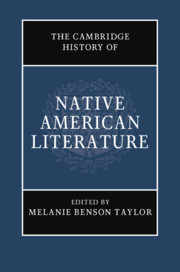Book contents
- The Cambridge History of Native American Literature
- The Cambridge History of Native American Literature
- Copyright page
- Contents
- Figures
- Contributors
- Introduction: What Was Native American Literature?
- Part I Traces and Removals (Pre-1870s)
- Part II Assimilation and Modernity (1879–1967)
- 7 The Multiplicity of Early American Indian Poetry
- 8 Native American Literature in the 1930s
- 9 Black-Indian Literature under Jim Crow
- 10 Transatlantic Modernity and Native Performance
- 11 American Indian Literature and Post-Revolutionary Mexico
- 12 I Kū Mau Mau (Standing Together): Native Hawaiian Literary Politics
- 13 Native Women’s Writing and Law
- Part III Native American Renaissance (Post-1960s)
- Part IV Visions and Revisions: 21st-Century Prospects
- Index
- References
12 - I Kū Mau Mau (Standing Together): Native Hawaiian Literary Politics
from Part II - Assimilation and Modernity (1879–1967)
Published online by Cambridge University Press: 18 September 2020
- The Cambridge History of Native American Literature
- The Cambridge History of Native American Literature
- Copyright page
- Contents
- Figures
- Contributors
- Introduction: What Was Native American Literature?
- Part I Traces and Removals (Pre-1870s)
- Part II Assimilation and Modernity (1879–1967)
- 7 The Multiplicity of Early American Indian Poetry
- 8 Native American Literature in the 1930s
- 9 Black-Indian Literature under Jim Crow
- 10 Transatlantic Modernity and Native Performance
- 11 American Indian Literature and Post-Revolutionary Mexico
- 12 I Kū Mau Mau (Standing Together): Native Hawaiian Literary Politics
- 13 Native Women’s Writing and Law
- Part III Native American Renaissance (Post-1960s)
- Part IV Visions and Revisions: 21st-Century Prospects
- Index
- References
Summary
Native Hawaiian literature has always provided a foundation of knowledge suggesting a course of action, particularly in times of tremendous social, cultural, and political upheaval. In this way, such literature has always been intertwined with politics. Despite settler colonial attempts to appropriate or subvert the political power of Hawaiian literature, Native Hawaiians continue to evoke traditional orature and compose new literature to directly respond to conditions of settler colonialism, while celebrating the beauty, complexity and continuity of our people and our connection to our land and culture. This essay traces the origins and development of Hawaiian literature as a strategy of national political and cultural consciousness. Reclaiming Indigenous literature from the settler colonial imaginary is an integral part of Hawaiian identity, sovereignty, and nation building. In practice and performance, contemporary Hawaiian literature is an expression of kū mau mau, standing together with a cohesive political purpose to uplift the nation.
Keywords
- Type
- Chapter
- Information
- The Cambridge History of Native American Literature , pp. 213 - 232Publisher: Cambridge University PressPrint publication year: 2020



